The best way to cook brown rice depends on what type of brown rice you have – and I cooked a LOT of brown rice to figure this out! Did you know brown basmati rice cooks in half the time of long grain, and short grain brown rice is better baked than cooked on the stove?
BIGGEST TIP – ignore the packet directions, DO NOT use the absorption method. And make this Brown Rice Salad!
Also see how to cook:
White rice | Jasmine | Basmati | Sushi rice | Risotto (easy way!) | Paella | Quinoa | Cauliflower rice
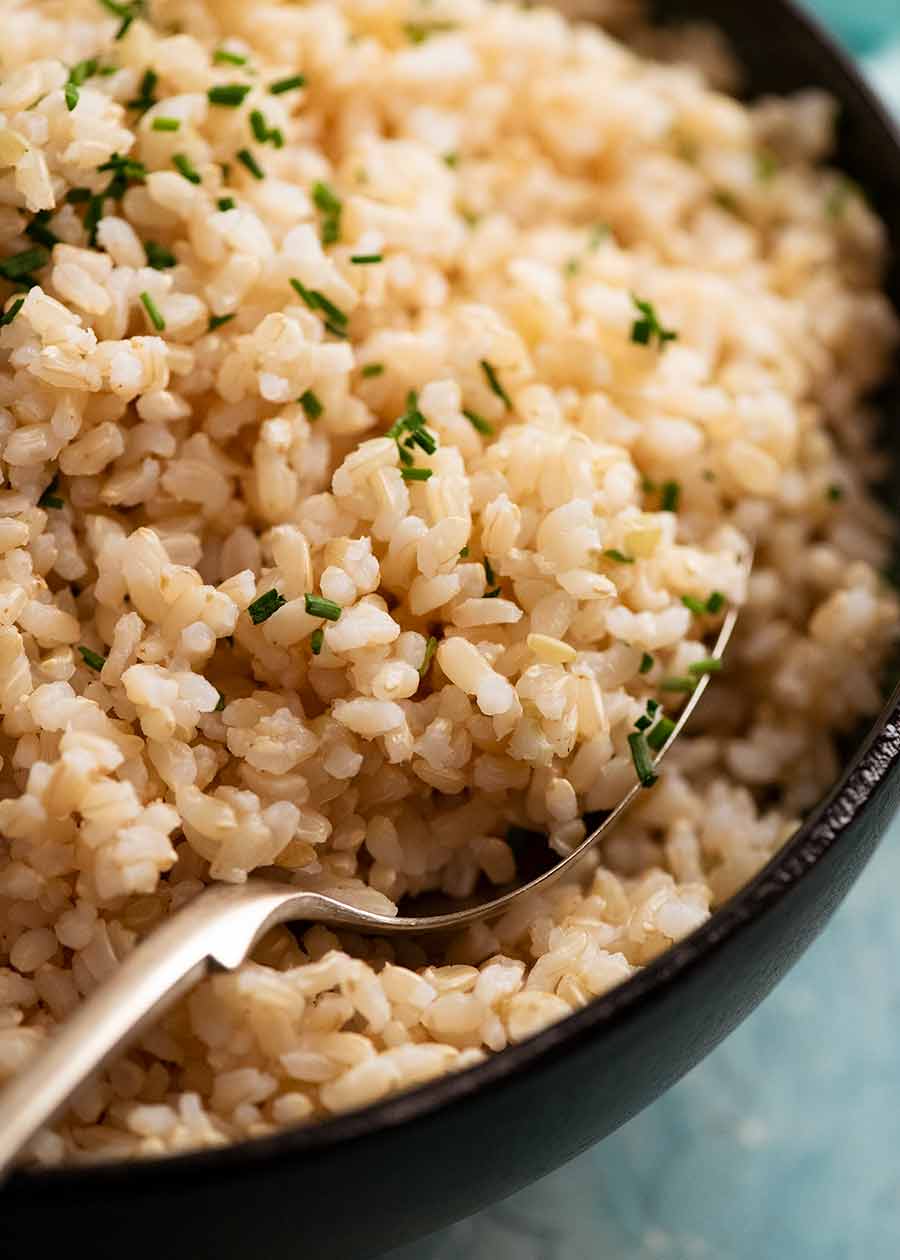
How to cook brown rice (perfectly)
This is a recipe for how to cook brown rice so it’s fluffy and tumbles out of the pot like THIS ↓↓
The challenge with cooking brown rice is that it has a harder hull than white rice, being the nutritious bran layer than is left on during milling. So all too often, recipes will lead you down a path to either overcooked mushy surfaces with cooked insides, OR the surface might be perfect but the inside is still hard.
The brown rice cook time varies drastically depending on what type of brown rice you have.
Well, you can ignore all those other recipes you’ve used in the past. This is all you need to know about how to cook brown rice perfectly and consistently, every single time:
Determine what type of rice you’ve got; and
Cook it according to the table below:

Using these methods, your brown rice will be….
Perfectly cooked all the way through – not overcooked and mushy, nor undercooked in the middle;
Will have a perfectly cooked surface that is neither gummy/slimy, nor unpleasantly wet and soggy;
Will have the slight chew that we love about brown rice, from the layer of bran that is kept on during milling – the good stuff, the flavour and nutrition!
Will be beautifully fluffy – if you used medium/long grain or basmati rice; or
Will be a bit sticky and clump together as intended – if you used short grain rice.
If you don’t know what type of brown rice you have, match it as best you can to the photos above.
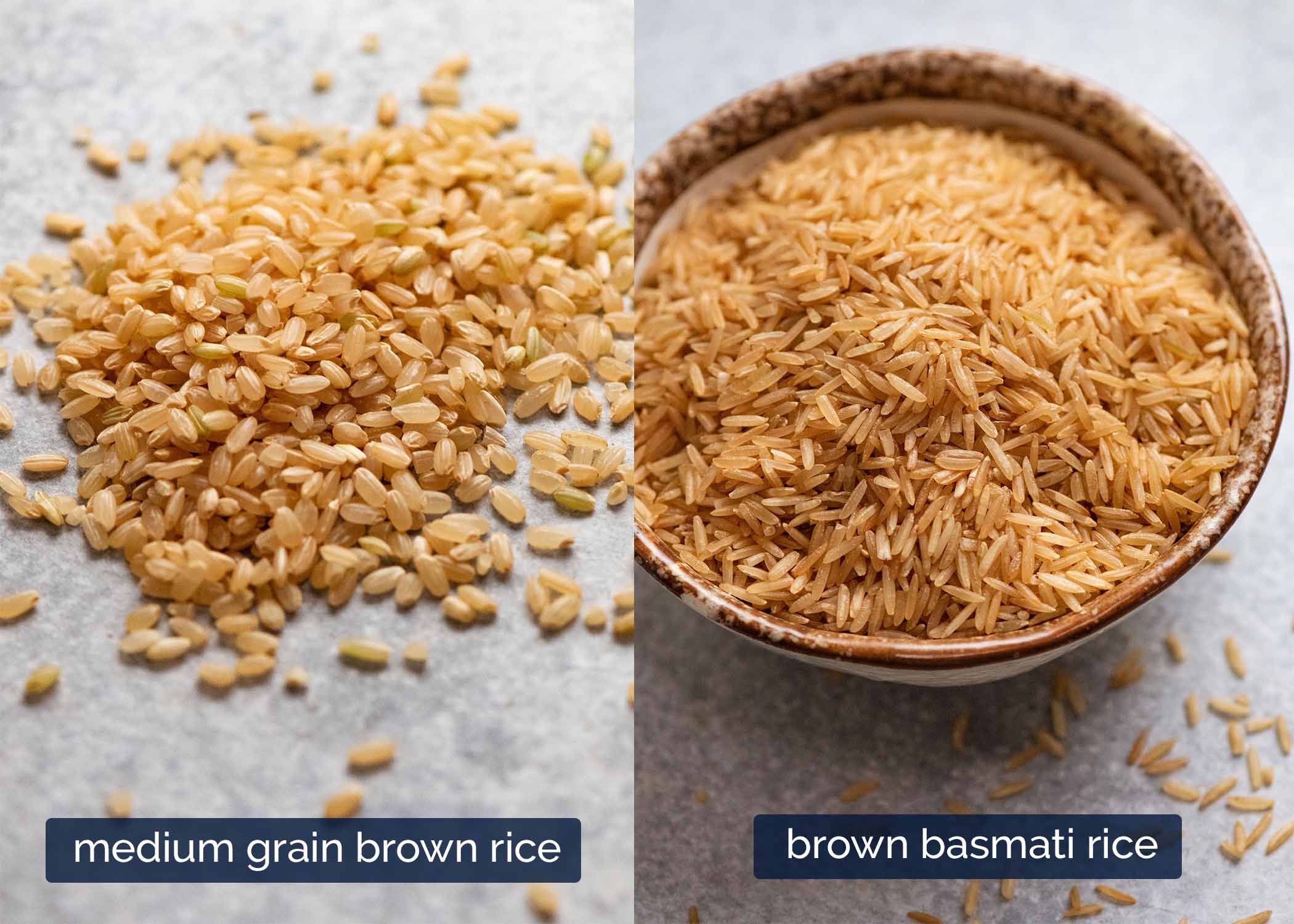
Boil and Drain Method
Use this for: medium grain, long grain and brown basmati rice.
Overview: This method is for long rice grains that cook up fluffy and separated, rather than clumping together. The rapid boiling keeps the grains agitated so they don’t stick together. This “hard and fast” boil method is ideal to cook through the tough, nutritious bran layer on the outside of brown rice.

The Boil and Drain method is just like cooking pasta – with one very important difference: resting. When the rice is drained, you will notice the grains are unpleasantly soggy. When you return it to the pot and leave it covered for 10 minutes, the grains will absorb the excess water and transform into fluffy perfection!
Boiling times:
30 minutes – medium grain and long grain brown rice
12 – 14 minutes – brown basmati rice
A KEY STEP many recipes get wrong
Take care to shake off excess water well when you drain the rice, and to tip out every drop of water from the pot so it steams dry with the residual heat. If you have a slick of water left on the base of the pot when you tip the rice back in, the rice will absorb that water and end up over bloated.
Also, make sure to put the pot back on the turned off stove while the rice is resting. That extra little bit of residual heat will help the rice “steam dry” to perfection.
This is brown basmati rice that’s been cooked using the Boil and Drain method:
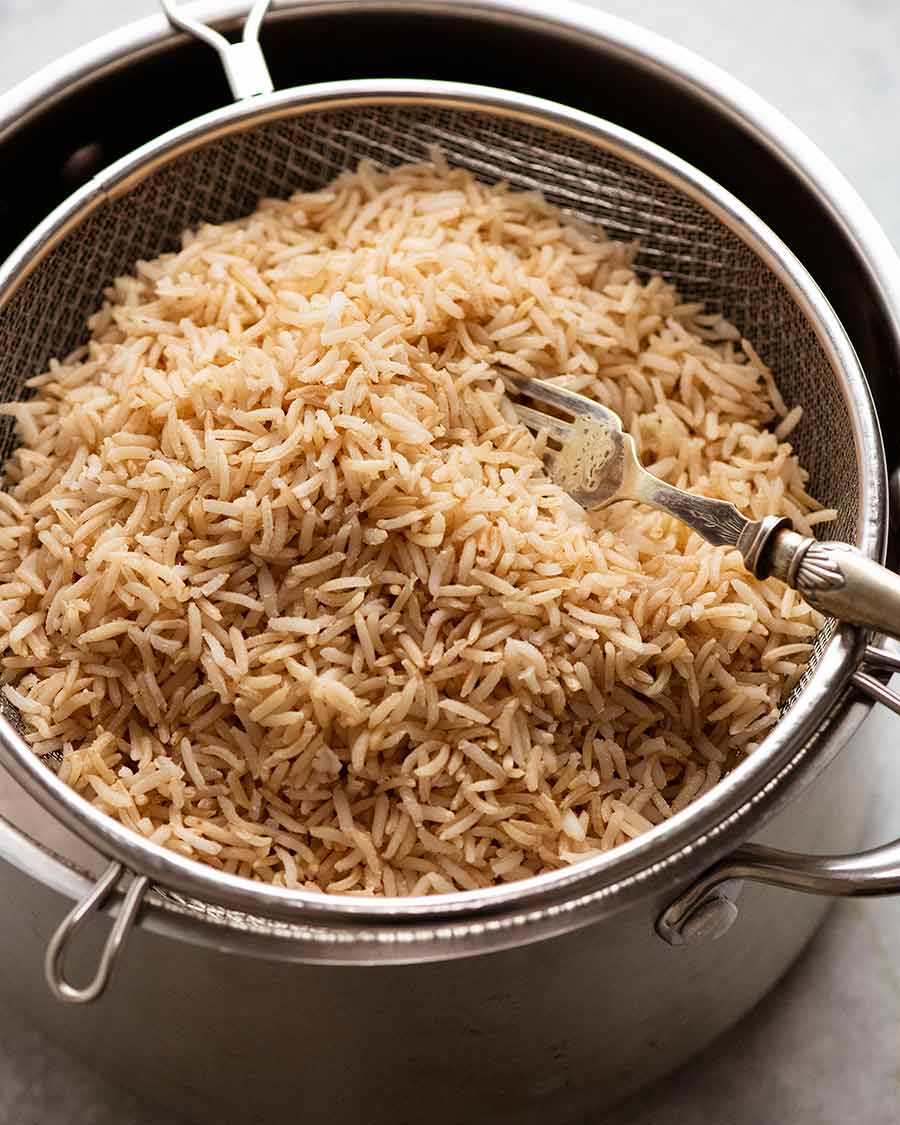
Baking Method
Use this for: short grain. Also very good for medium grain and long grain (though Boil and Drain is better for these).
Overview: Excellent entirely hands off method to evenly cook through brown rice. Marginal bits of crispy brown rice on the rim of the surface, but it doesn’t bother me in the slightest. (In fact, I want to pick them off for myself!)

This massively overlooked method of baking rice is ideal because the baking vessel is not in direct contact with the heating element (like with stovetop cooking) so you don’t have to worry about a scorched base, and the long, slow 75 minute cook time allows for the tough outer layer of the brown rice to cook through perfectly.
Key Step: BOILING water
It is important to use BOILING water not cold tap water for the baked method. Otherwise it takes a good 15 minutes or so for the water to heat up enough to start cooking the rice during which the rice is just wallowing and bloating in warm water, resulting in mushy rice.
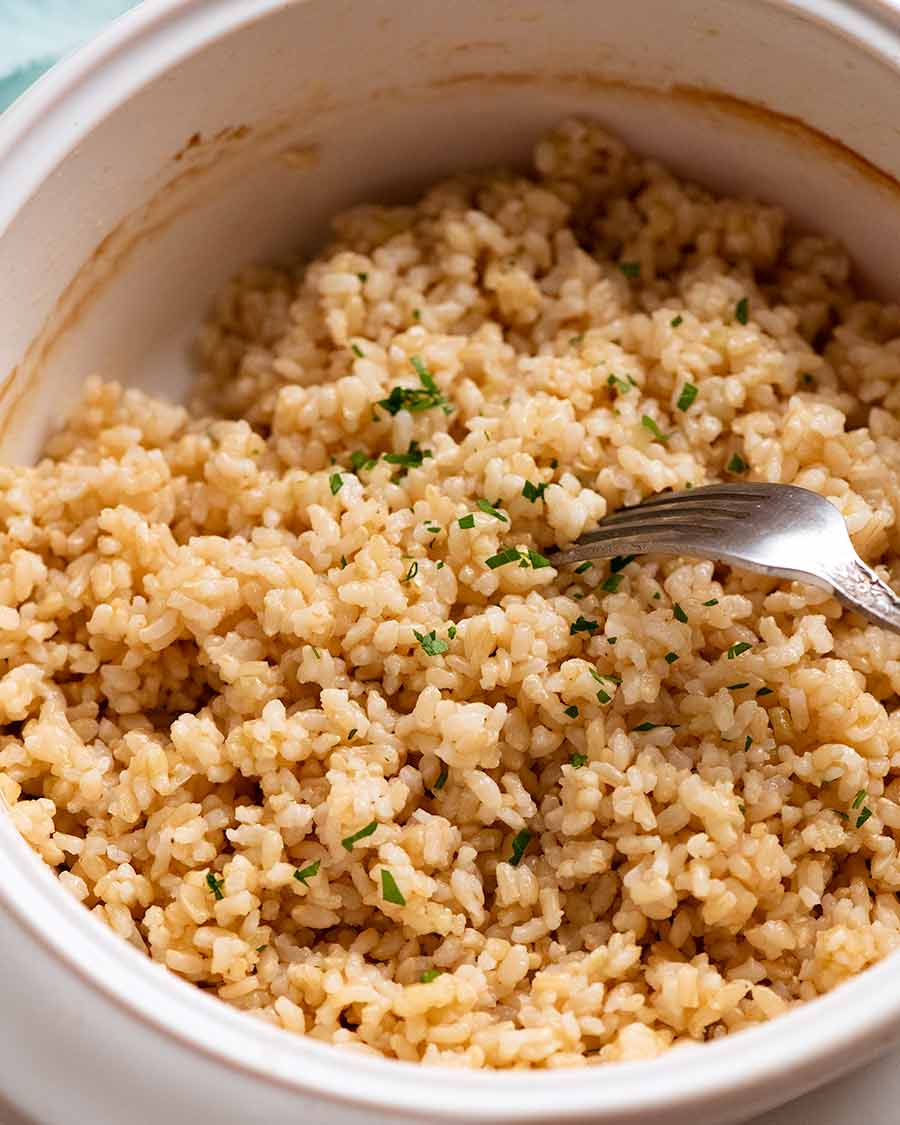
NO to the Absorption Method!
The Absorption Method of cooking rice is the method whereby rice and water is put in a saucepan and cooked over low heat so the rice absorbs the water, and it is NOT drained. This is how I cook all white rice – everyday rice as well as Jasmin and Basmati.
While it can work if you soak the rice for 2 hours, then cook on a low heat for 30 minutes, I concluded that it was not the best nor easiest method for brown rice because of the following
It’s difficult to achieve consistency – sometimes the rice comes out pretty good, cooked through with a nice surface on each grain. But sometimes, it came out with a slimy or gummy surface which is really unpleasant. A perfect result is highly susceptible to minor variations in pot size and stove strength. I also got friends to try, and had mixed results;
Not as good as Boil & Drain or Baking – even when I “nailed it”, the rice isn’t as good as using the Boil & Drain or Baking Methods. The rice in the lower part of the pot was always more wet and slightly softer than ideal.
Conclusion: give the absorption method a miss!
Why is it so hard to cook brown rice using the Absorption Method?
Because brown rice grains have a hard nutrition hull (the bran layer which is removed for white rice). This is tougher and takes longer to cook. It is very hard to find the perfect balance using the low-heat absorption method such that the hard hull is perfectly cooked in the same time it takes for the inside cooks through. All too often, you end up overcooking the hull in order to cook the middle (ie mushy outsides), or undercooked hard inside with perfectly cooked outsides.
Here’s a “successful” pot of brown rice cooked using the Absorption Method. It’s hard to tell from a photo, but these rice grains were softer and far less fluffier than using the Boil & Drain Method AND Baking Method (this is medium grain brown rice).

Different types of brown rice
Technically, any rice that doesn’t have the hull removed is a brown rice, so this includes things like red rice, black rice etc. But for the purpose of this recipe, I’m covering the four common types of brown rice (all pictured in graphic at top of post):
Short grain brown rice rice – short and stubby, this cooks up sticky so the grains clump together, making it ideal to pick up with chopsticks and use for things like sushi where you want the rice to stick together. This is rare in Australia, I’ve only used it a handful of times, always from speciality stores or markets. And I’ve also read that it’s common for short(ish) medium grain rice to be labelled “short grain rice”. Most sushi shops in Australia appear to use medium grain brown rice;
Medium grain brown rice (below left) – slightly longer than short grain, this is a great all rounder that is slightly stickier than long grain, but not as sticky as short grain (just sticky enough to make sushi rolls). Most common rice type in Australia;
Long grain – longer still, cooks up fluffy and doesn’t stick together as much (though it still does a bit). Ideal for salads (think – tossing with dressing); and
Basmati (below right) – the least sticky of them all! Traditionally from the Indian sub-continent so ideal with all things curry as well as Middle Eastern foods.

When to use which rice?
When used cooked – like serving with stir fries, or in rice salads and rice soups – the type of brown rice doesn’t really matter except for things like sushi when the rice needs to stick together (use short grain).
However, it does matter when uncooked rice is used in a recipe because the cook time and liquid amounts required depends on the type of brown rice used. The recipe author should (hopefully!) specify which type of rice to use.
Pro tip: you get what you pay for
Not all rice is created equal. If you buy economical house-brand rice, it will not taste as good as the premium brands. This is particularly prevalent with basmati rice – the cheaper brands will always taste more “crumbly” and almost watery, whereas premium quality has a much definitive, pleasant texture and flavour. This applies to both white and brown rice.
I am in Australia and I typically use SunRice (Australia’s largest rice producer) which is a very good quality for everyday purposes.

What to make with brown rice
Ahh, the possibilities in your newfound perfectly-cooked-brown-rice life!! To smother in stir fries, make fried rice, rice salads (this one or this fabulous new one), and the hundreds of recipes on my website that end with the words “serve with rice”.
Basically, anytime a recipe calls for using or serving with cooked white rice, switch it out with brown rice for the added health benefits and flavour!
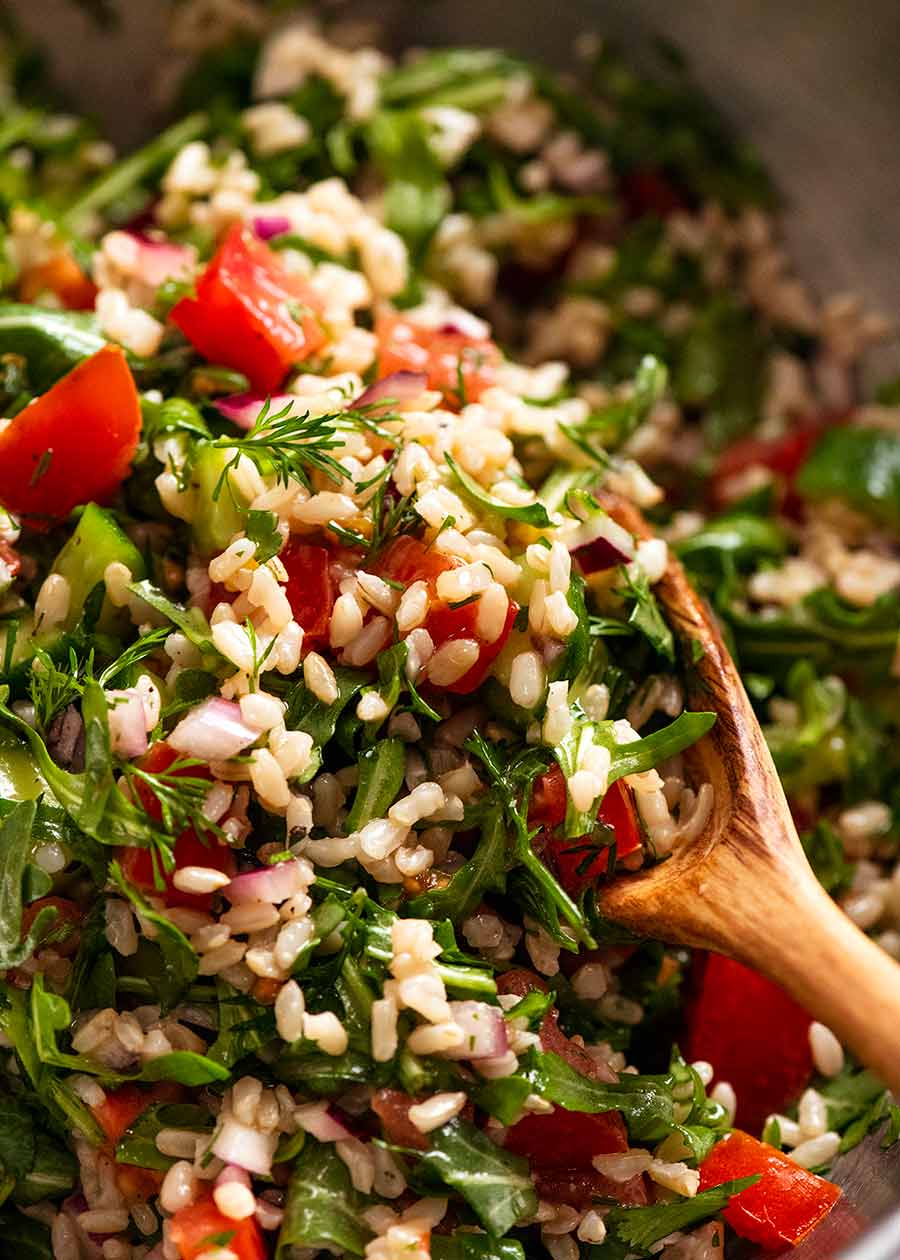
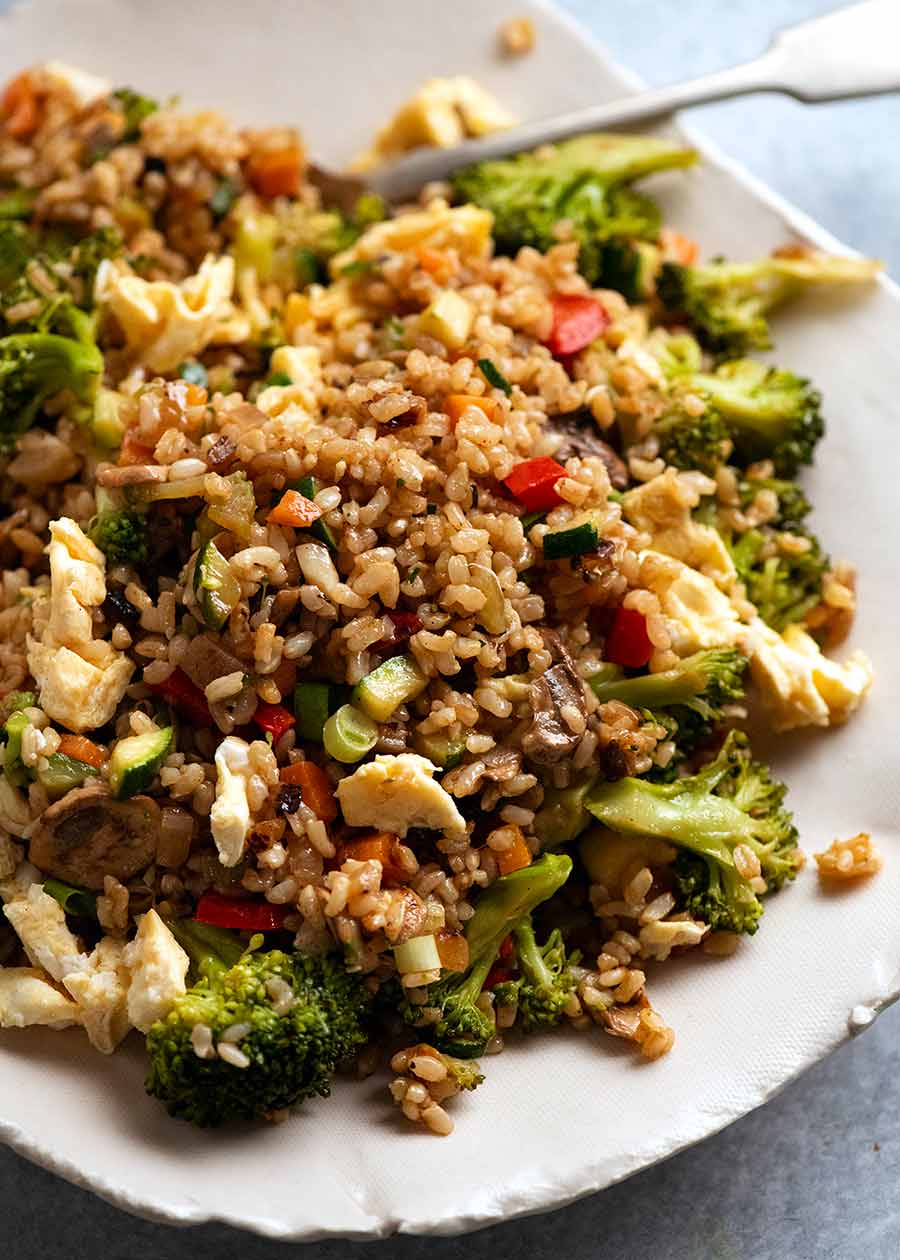
PRO TIP: Fried rice is excellent made with brown rice because the grains are a little firmer than white rice so you don’t even need to refrigerate overnight! I have quite a few for you to choose from:
FRIED RICE RECIPES to make using brown rice
Also, if you clicked on the brown rice testing matrix and are wondering what on earth I did with all that rice (especially the many batches of mushy rice!), it just so happens that Dozer’s homemade dog food includes soft cooked brown rice so it all went to him!
That’s why I didn’t mind experimenting – because I knew none would go to waste. As a child, we were scolded for leaving a single grain of rice in my bowl. “A rice farmer picked that with his bare hands!” my mother would tell us, guilting us into respecting every grain of rice.
I do think that even back then, the farmers had a little help from machinery. 😂 But it was still a lesson well learned! – Nagi
Why brown rice is better for you
Brown rice has more nutrition than white rice which is mostly just empty carbs. During milling, the hull of rice grains is removed to make white rice. This hull is left on for brown rice, and it contains bran and germ that contains fibre, vitamins, minerals and antioxidants, all of which are good-for-you nutrition.
Watch how to make it
Hungry for more? Subscribe to my newsletter and follow along on Facebook, Pinterest and Instagram for all of the latest updates.

How to cook brown rice
Ingredients
Boil and Drain:
- 1 cup brown rice – medium grain, long grain or basmati
- 8 cups water (Note 1)
Baked Rice:
- 1 1/2 cups short grain brown rice (medium grain ok too)
- 2 1/2 cups BOILING water (Note 2)
Will NOT work for / not yet tested:
- Quick cooking rice (ie par boiled) – will not work
- Brown jasmine – not yet tested
Instructions
- Rinsing rice: only required if you purchased from bulk bins. If you rinse, reduce water by 1/4 cup for baked version.
Boil and Drain:
- Boil water: Bring water to a boil in a small pot or large saucepan over high heat.
- Boil rice: Add rice, then boil rice until just cooked, a tiny bit firmer than you want (it gets softer during Rest step). Use these times as a guide (Note 3):– Medium and long grain rice: 30 minutes– Basmati rice: 12 minutes (1st check) to 14 minutes
- Drain VERY well (key tip! Note 4): Drain rice in a colander, shaking the pot well to remove as much water as you can, and shaking the colander to remove excess water from the rice. Pot should steam dry from residual heat.
- Rest: Return rice to now-dry pot. Put lid on and put it back on the turned off stove. Leave for 10 minutes.
- Fluff and serce: Fluff rice with fork and serve.
Baked Rice:
- Preheat oven to 180°C/350°F (all oven types).
- Combine rice and water: Pour rice and boiling water into a 20cm/8" square pan or round casserole pot. Cover with lid or foil.
- Bake 1 hour 15 minutes.
- Rest, fluff & serve: Remove from oven, stand 10 minutes then fluff with fork and serve.
Recipe Notes:
- Short grain – this sticky rice is best baked. Boil and drain isn’t suitable for sticky rice.
- Medium grain – sits between sticky short grain rice and fluffy long grain rice. Boil and Drain is best (fluffiest result) but baked is very good too (useful hands-off method).
- Long grain and basmati – these long slender grains of rice are most definitely best cooked using the Boil and Drain method for the fluffiest result. Baking works too, but the texture of the rice at the base ends up stickier than ideal, while the rice on the surface is closer to what it should be.
1. Water volume – as you scale up the recipe, you don’t need to scale up the water volume as much. You just need plenty of water that the rice can absorb (it will almost triple in volume) and enough extra bubbling water to keep the rice bouncing around. Think of it like pasta! So for 1 cup rice, you need 8 cups water, but then for 2 cups of rice, you need only 12 cups of water. And so on. 2. Boiling water – important to use boiling water to skip the time it takes for water to heat up in the oven. If you don’t use boiling water, the rice is just soaking in water for 20 minutes or so until it starts cooking, and you’ll end up with soggy rice (as well as increasing cook time). 3. Why do you have to check early when boiling? Because I’ve found that from brand to brand, the perfect cook time can differ. It’s utterly frustrating! But there seems to be no universal standard for brown rice grain sizes, and rice can go from perfect to overcooked in mere minutes. So the golden rule is – CHECK EARLY! (And once you’ve perfected your preferred rice brand, you’ll know the perfect boil time – stick it on your fridge!). 4. Excess water – shaking off excess water from rice and pouring out every drop of water from the pot so it steams dry in seconds with the residual heat are two key tips for perfect rice using the Boil and Drain method. If the rice is soggy or if the base of the pot is covered in water when you return the rice to the pot, it will absorb that water and end up over bloated. Resting rice after cooking is especially critical for Boil and Drain because the rice is “wet” straight out of the pot. During the resting phase, the water on each rice grain gets absorbed into the rice, leaving you with perfect rice grains! 5. Rinsing rice – You don’t need to rinse brown rice for it to be fluffy with these cook methods. You only need to rinse if you are concerned about cleanness – eg if you purchased from bulk bins. How to rinse rice: Place rice in bowl, fill with water, swish until murkey, drain, repeat 3 more times. Water will never be fully clear. If you rinse, DO NOT leave rice soaking in water before cooking, it will affect the cook time (soaked rice cooks faster). In fact, you should rinse immediately prior to cooking. If you rinse rice, REDUCE water in Baked Method by 1/4 cup (65 ml). 6. Nutrition per serving, assuming 1 cup of uncooked rice serves 3 people.
Nutrition Information:
More Life-Essential Rice recipes
Because nobody likes mushy rice…nobody!
Life of Dozer
I went searching for a photo of Dozer’s homemade food mix which includes soft cooked mushy brown rice (the perfect use for all the failed batches of brown rice!). This is the only one I could find – from that time I was putting his bowl together and a bit of his food flew into my mouth!! 😂

For those who are interested, here is his homemade dog food recipe, but please do not use it without consulting your own specialist or doing your own research because I am not an expert (only an expert on Dozer’s food!).


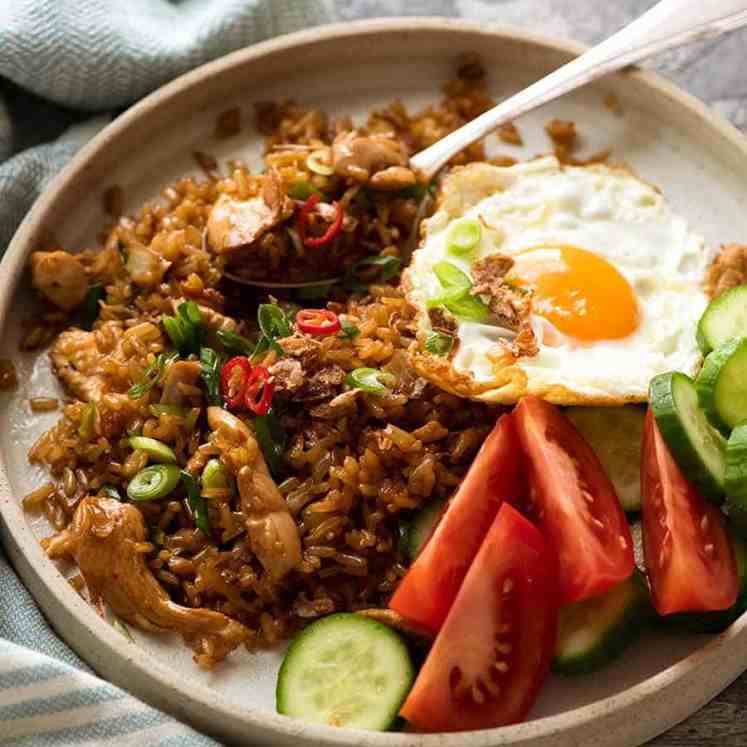
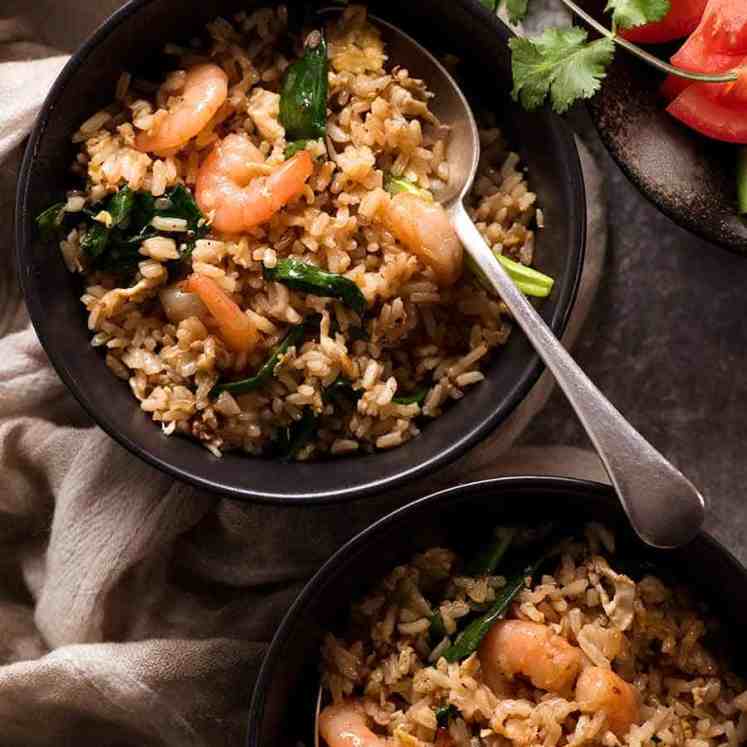


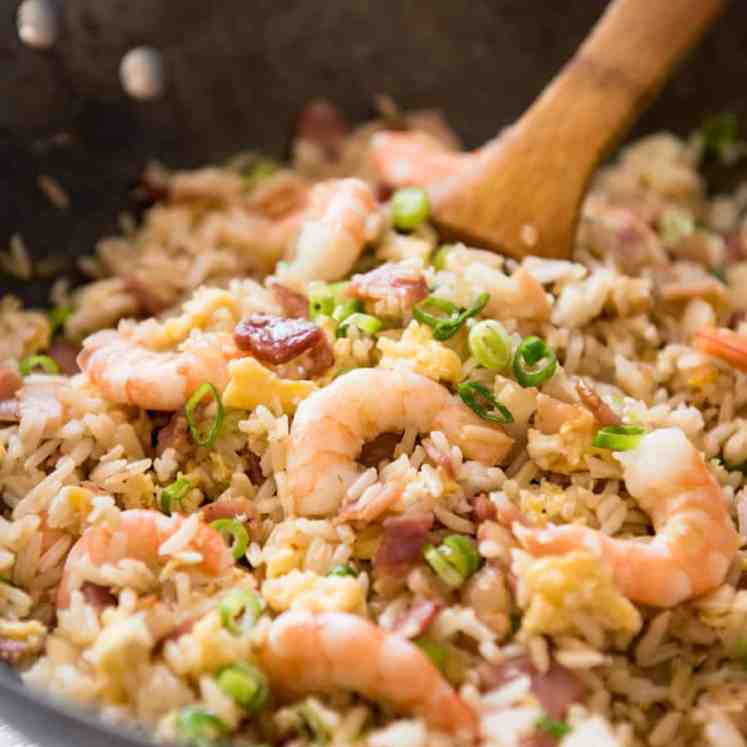


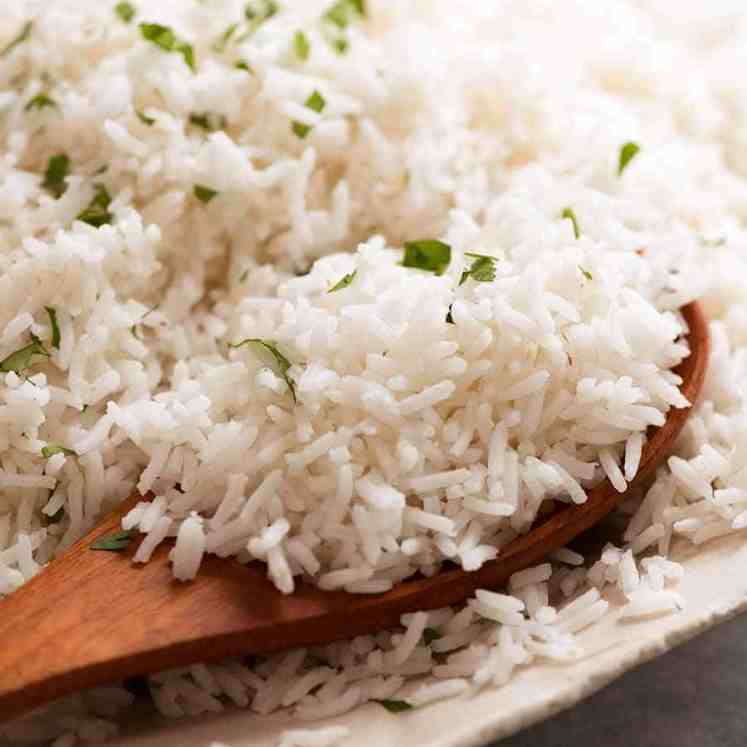
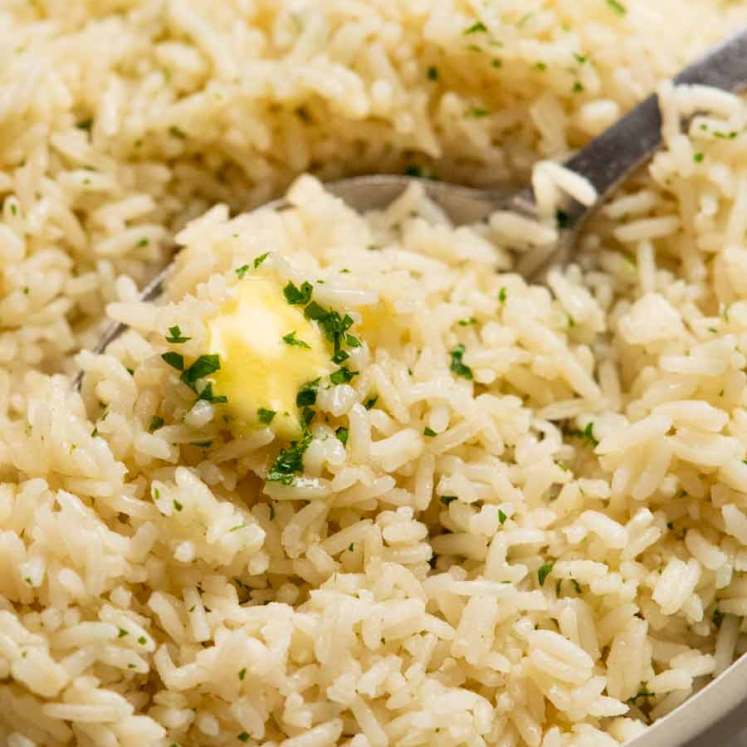


This is the best brown basmati rice I’ve ever made! Usually it’s soggy and chewy, but this was perfect! THANK YOU! And my husband thanks you too!
A simple thing but how well your rice is cooked (or in some cases undercooked or overcooked) can make or break that delicious Nagi meal you have just made. I now confidently know that I can put my rice on to cook for 30 minutes and not worry about it and that it will be delicious. Thanks Nagi for all your testing and notes, again making me look like a confident and proficient cook.
Hi Nagi! I love your site. When I found your brown rice recipe and tried it, I loved it so much that it has become my go-to method for making rice! I like both the boil and the bake method and use whichever one I have time for. Right now I have it in my oven cooking!
I have 2 questions:
1 – Regarding the servings, one spot on the page says “Servings: 1 cup uncooked brown rice makes 3 cups cooked rice which will serve 3 people.” then further down it says “1 cup uncooked brown rice = 2 3/4 cup cooked = 2 to 3 servings.” Which is correct?
2 – Step 4 under baked rice says “Rest, fluff & serve: Remove from oven, stand 10 minutes then fluff with fork and serve.” Should we keep the lid/foil on while resting or take it off?
Thanks for your clarification!
Thank you for helping me get perfectly cooked brown rice!
Even though I had medium grain brown rice, it only took 16 minutes to boil to the desired texture so thanks for adding in the tip to check early.
Brilliant! Used the medium grain boil method. I think they key is the 10 minute rest at the end. Thank you 😊
Nagi, WOW! I have just baked brown rice and for the first time am enjoying the beauty of brown rice! Never again will I try and cook it differently. Thank you and WOW! Fluffy brown rice is a real thing!
Hi Nagi, can you add salt to the boiling water ?
Yes I always salt my rice (lightly!). In my world, everything needs seasoning especially carbs! I do not enjoy unsalted rice. I use 3/8tsp table salt per 325ml water for lightly salted rice. Note: I cook 200g rice (1 cup) in 1L water (4 cups) so the rice naturally absorbs more salt (very little water at the end so salt is more concentrated at this stage). In the past I used 1/2tsp per 325ml water but now find that too salty so feel free to reduce amount to your preference! Hope that helps 🙂
The baked short grain rice turned out perfectly! I would actually like to make more at a time than this recipe calls for. What is the easiest way to scale up the water for the baked rice? I personally would like to cook 3 cups of short grain brown rice at a time. Thank you!
I was a little hesitant to follow the instructions but I’m glad I did. Came out perfectly. My only question is sometimes I like to flavor the rice with either stock or a bullion but the idea to throw out those flavorful stock makes me wonder and ask you…how to cook in the stock flavor without draining the precious liquid?
Oh my GOODNESS! I’ve tried cooking different types of brown rice in two different rice cookers and also in the oven but it always came out mushy. 🙁 but I just found your recipe and boiled my brown rice like you said and it’s AWESOME!! I can make an adjustment or two to make it even better but even now it doesn’t hold a candle to the mush I cooked before. I’m really interested in learning to cook Indian and Thai food and your recipe definitely leads me in the right direction. Thank you, thank you, thank you!!!!
Best regards,
Becky Fitzgerald
Does the rice cook covered or u covered? Hello when I put the rice in it stops boiling especially since you don’t say if it’s covered or not the pot… Help. Please.
We always get the water up to boiling with a lid on. When it is boiling we add the rice and leave the LID OFF. When it starts boiling again we turn down a little bit. Hope that helps. We use Lundberg’s short grain brown from costco
Hi after rice boils first time do u putt the lid on and cook for 14 minutes?
We always get the water up to boiling with a lid on. When it is boiling we add the rice and when it starts boiling again we turn down a little bit. Hope that helps. We use Lundberg’s short grain brown from costco
Thank you very much Nagi.. used Medium Grain boil method and it worked perfectly!
Can you comment on Doongara Rice please?
Hi Jani,
I used Nagi’s recipe for medium grain brown rice to cook Doongara brown rice today and worked out perfectly! Used 2 cups right with 16 cups water x
Can you give a time for Doongara brown rice please?
Husband just been diagnosed with elevated sugar levels so we have reverted to brown rice when we have rice. We used Tilda basmati and it turned out perfect. Thank you so much.
Goodness Nagi, you are wonderful, this brown rice post is very helpful. Thank you.
I made brown Jasmine using the boil method. It took two tries to get it right and I can now report with confidence that mine took approx 22 minutes of boiling to get to “al dente”. I drained and let sit in the pan for 10 mins and it turned out perfect! Thanks for this method, I never made great rice until now.
Amazing and easy. I had all but given up on cooking brown rice as it never seemed cooked! Now, it’s perfectly fluffy. Thank you.
I’m glad I could help Lisa! N x
you are my new Goddess in the kitchen!
When cooking 2 cups of brown rice is the correct amount of water 12 cups (as per note 1 in the recipe) or 16 cups (which is the amount given when you change the quantity until you get to 2 cups of rice) in print view ?
I can supply a PDF of the print view of the recipe if the would help.
Love you work!! And your recipes!!
Thank you,
Fiona